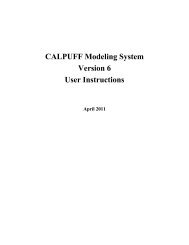Volume 1 - The Atmospheric Studies Group at TRC
Volume 1 - The Atmospheric Studies Group at TRC
Volume 1 - The Atmospheric Studies Group at TRC
Create successful ePaper yourself
Turn your PDF publications into a flip-book with our unique Google optimized e-Paper software.
Meteorological d<strong>at</strong>a used in the OCD4 evalu<strong>at</strong>ion d<strong>at</strong>aset includes wind speed and<br />
temper<strong>at</strong>ure measured by tethersonde <strong>at</strong> the release loc<strong>at</strong>ion, and air-sea temper<strong>at</strong>ure<br />
difference obtained <strong>at</strong> a nearby oil pl<strong>at</strong>form.<br />
Geophysical Processing<br />
Gridded land use and terrain elev<strong>at</strong>ion d<strong>at</strong>a for the CALMET geophysical file are<br />
obtained from the USGS. <strong>The</strong> terrain d<strong>at</strong>a are from the one-degree 1:250,000-scale<br />
DEM d<strong>at</strong>aset, with an approxim<strong>at</strong>e resolution of 90m, and from the 1:100,000-scale<br />
DEM d<strong>at</strong>aset with 30m resolution. Land use d<strong>at</strong>a are from the 1:250,000-scale CTG<br />
d<strong>at</strong>aset, with a resolution of 200m. Because the sp<strong>at</strong>ial vari<strong>at</strong>ion in terrain elev<strong>at</strong>ion is<br />
important <strong>at</strong> this site, a 100m grid cell is selected for the modeling grid. This grid is<br />
positioned so th<strong>at</strong> a single 200m land use cell is centered on a cluster of four of the<br />
100m grid cells. <strong>The</strong> modeling grid chosen to cover the area is defined by:<br />
Map Projection: UTM (Zone 11N)<br />
D<strong>at</strong>um: NAS-C (North American 1927)<br />
SW Corner Coordin<strong>at</strong>es (km): (267.0,3805.0)<br />
Number of cells (nx,ny): (100,100)<br />
Cell Size (km): 0.100<br />
<strong>The</strong> CALMET preprocessors TERREL, CTGPROC, and MAKEGEO are applied to<br />
convert the geophysical d<strong>at</strong>asets to this modeling grid, cre<strong>at</strong>ing the CALMET<br />
GEO.DAT file.<br />
No coordin<strong>at</strong>e transform<strong>at</strong>ions are required for the source and receptor loc<strong>at</strong>ions<br />
listed in the OCD4 model runs because they are already in this projection. <strong>The</strong><br />
resulting map of the experiment region is shown in Figure 4-2.<br />
Source & Receptor Characteriz<strong>at</strong>ion<br />
Tracer releases are characterized as modeled in the OCD4 evalu<strong>at</strong>ion. All are<br />
modeled without downwash.<br />
All sampler loc<strong>at</strong>ions are used as receptors, but additional ones are added to increase<br />
the density of receptor spacing along the two primary arcs in each experiment.<br />
Intermedi<strong>at</strong>e receptors are placed <strong>at</strong> approxim<strong>at</strong>ely 50m intervals, with elev<strong>at</strong>ions<br />
interpol<strong>at</strong>ed from the actual sampler elev<strong>at</strong>ions. 93 receptors are used in modeling<br />
the complex terrain study periods, and 75 are used in modeling the fumig<strong>at</strong>ion study<br />
periods.<br />
Final Report Vol.1 33







